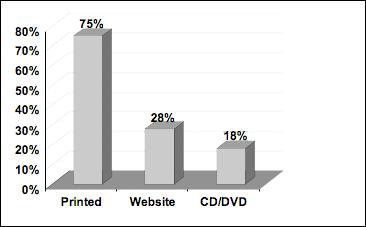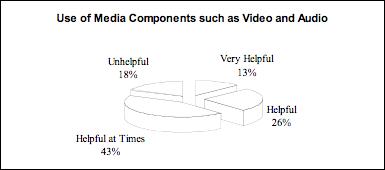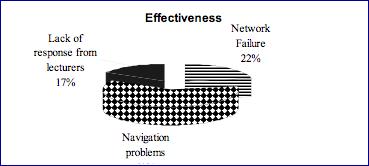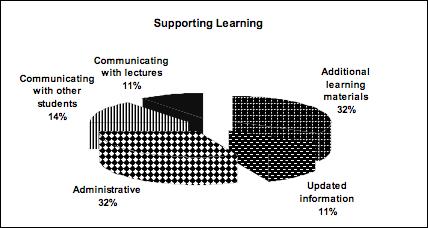N=101
Representation of Learning Materials The survey investigated the student teachers preferred format of representation of learning materials, and found that 75% preferred the printed format.
Figure 1: Preferred media
Students were asked to rate the effectiveness of multimedia features such as audio and video elements for their learning. 43% of the respondents indicated that it was helpful at times, only 13% found it very helpful. N=93
Figure 2: Audio and Video
Interactions, contributions, and collaboration The participants were asked to describe their use of the sharing and collaborating features available through Interact, and quantify their level of contribution to online discussion forums using the following scale:
Table 2: Interactions and Collaboration
Table 2 identifies 4 types of interactions:
Table 2 indicates that 45% of the respondents contributed messages, however, only on rare occasions (1-5 messages per course). This finding raises questions as to why such a relatively high percentage of participants sustain such a low frequency of posting messages. One explanation to this query can be found in the words of one of the participants: "I have been really frustrated by the number of people who read the questions or comments but don't respond. In the beginning I would post in each course, but it became apparent that other students were not using it as a means for dialogue, so I stopped doing it as I felt I was wasting my time".
Table 2 describes a situation of an unfortunate loop in which people cease to participate in the online discussion and perceive it as a 'waste of time' because 'other students are not using it as a means for dialogue'. This loop phenomenon is fully realised when analysing all the other types of interactions shown in the table. Posting a message to a discussion forum is usually an invitation to some type of interaction. According to table 2 a total of 70% ( 5% on several occasions 20% on some, and 45 on rare occasions) did initiate an invitation for interaction. However, 65% of the participants indicated that they have never contributed comments, 61% indicated that they never exchanged information. In other words, people initiated a conversation on the one hand, but refrained from responding to other people's invitations, resulting in breakdown of communication. This situation illustrates a discrepancy between what people expect from discussion forums and what happens in reality. On the one hand participants noted:
Participant one: "It [discussion forums] is good because you know that someone is going to see your posting and be able t help you out". Participant two: "Using the forums is effective in getting responses from lecturers for all concerned. Students can also 'talk' to each other via Interact". In other words, students have an initial positive perception of ways in which online interactions can contribute to their learning, as participants indicate: "When I had difficulty with course material it helps to be able to read what other students are saying. To be able to see lecturers comments or replies Posting questions and concerns on Interact enables the lecturers to respond and often their answers help many people with the same concerns. Communication with other students is a lot stronger than it would be without Interact. We are able to see others' postings and have the opportunity to share out thoughts". Other participant: "Talk to others wouldn't normally[without the online system] get to. Process questions and comments also. Can leave class mates messages etc". However, in reality the practices exhibited, deter students from perusing their initially positive approach, and they turn to using other means, as one participant said: "I prefer to get an email rather than spend ages on Interact looking for communications that aren't often there. Would be OK if lecturers posted things regularly".
The need for better response and rapport with lecturers was mentioned by a number of participants saying: Respondent one: "I have made postings, and haven't had reply from my lecture….." Respondent two: "I find it terrible how you often ask lecturer a question and they don't reply" Others mention the lack of response from both students and lecturers: "….. lecturers and students not answering questions….." Supporting Learning The survey reviewed the ways in which participants found the use of Interact as supportive to the learning. Measuring the frequency of appearance of reoccurring words such as good' useful' 'support', 'communication', 'helpful', 'extra', 'fantastic', 'available', and 'easy' enabled the construction of a rough sketch of students' expectations of the system, and the level to which these expectations were met. Most students (78%) found using Interact helpful to their learning in some way. 22% argued that Interact was not helpful at all to their studies. The hindering factors pointed out by the respondents related to network failure, bad website navigation, and lecturers failing to reply. Figure 7 illustrates the effectiveness of the system
N=86
Figure 3: Effectiveness
To investigate the ways in which Interact supported learning, I used the Balbi and Di Meglio (2004) Text Mining approach of Text Categorisation and detected 5 categories of supportive factors:
N=86
Figure 4: Supporting learning
32% respondents found the system helpful for its addition to learning materials 11% used it as an updating source of information 32% used it for administrative purposes 14% used it for communicating with other students 11% for communicating with lecturers
The findings indicate that the majority of the respondents perceive interact as a tool for disseminating learning materials, and administrative information. Furthermore, student's responses confirm the quantitative data: "My use of the' interact' has mostly to locate information, assignments templates, etc. which has been most helpful to my learning". "keeping up –to-date with assignment requirements and due dates…." The findings indicate that students predominantly see the system as a source of information to be disseminated by the lecturer and course administrators.
The importance students attribute to the information provided through interact is summarised by one student saying: "There is a wide variable amongst lectures who make good use of Interact as a form of communication. The course which were regularly updated and monitored gave the best support and the highest level of communication"
ANALYSIS The analysis section follows the same subtitles introduced in the 'findings' section.
Computer access preferences The college's computer suits enable students to work together, view each other's computer screens, exchange comments, tips and help each other. 11 out of the 22 on- campus students chose to use the college computers for the opportunity of enjoying the company of their peers, indicating that the students' value the opportunity for sharing and collaborating with peers.
Representation of learning materials 28% of the students chose Web representation as their preferred medium of learning materials; however, 75% chose print. The scope of this study did not allow for further investigation of these findings, but some possible alleys for further investigation could look at reasons to do with:
43%of the students found the use of video and audio components as helpful at times. This rather ambivalent response is contrary to the wide use of visual and sound so ubiquitous in today's world. The scope of this study did not allow for further investigation of this finding, and further study is needed for identifying the reasons behind the phenomenon observed. Possible routes for explanations implied in literature will be discussed in the summary of this section.
Interactions, contributions, and collaboration Summing up the personal experiences of the respondents with the use of discussion forums indicate that the low percentage of use seems to emanate from two key reasons:
When asked about the amount of information exchange, 61% of the respondents have never participated in such an activity. This finding could be interpreted in many ways;
Ascertaining the reasons for the findings in this case is beyond the scope of this paper; however, the current findings shed some light into areas needing further investigation. The survey showed very low levels of exchange, sharing contributing and commenting on each others materials. Once again the reasons for this could be similar to the ones I have outlined earlier. It may be that not enough preparation and exposure to these features was done in the level of lecturers or the students. The findings may well be an indication of the fact that lecturers, as the ones responsible for designing and leading the courses, have not made the pedagogical shift and are not yet ready to implement current pedagogies where students will be more active, and the role of the teacher will become that of a facilitator rather than a transmitter of information(Duffy & Cunningham, 1996).
Supporting learning Similar to issues raised in previous items in this section, the effective use of Interact was again attributed to lecturers' response. The need for lecturers' response has to do with students requiring lecturers' presence, and the assurance that someone, 'out there', is listening. The low percentage of students who perceived interact as a tool for communicating with other students highlights a fundamental finding, indicating that learning is still perceived as teacher centred activity in which students receive information and instructions and act accordingly.
Concepts arising from the analysis Two key issues seem to arise from the analysis of the findings illustrating the perceptions student teachers' have for using of ICT in a learning context:
Preferred Medium -The overwhelming (75%) preference to print media implies a traditional approach to the presentation of learning materials. Further strengthening this finding could be attributed to the high percentage of response to the printed rather than the electronic version of the questionnaire disseminated for this study. Interaction and collaboration -The relatively low use of the social collaborative features supported by the ICT system interact, may imply that the social learning pedagogy underpinning the design of Interact have not been widely implemented, and practices seem to fall back on the more traditional teachers' centred approach. This observation is supported by the findings shown in figure 4 indicating a relatively high use of the system for obtaining learning materials and course administration information. The two key findings stand in relative contrast to the general view that ICT use is rising, and that young people in particular are high users of audio visual functions supported through ICT(Oblinger & Oblinger, 2005), and are keen users of interactive social networking technologies such as MySpace or Facebook (Lenhart & Madden, 2007). A closer investigation of the nature of the use of technologies such as iPods, picture phones, and audio visual Web application such as YouTube, Flicker and others, and the various networking systems, reveal that they are all primarily used for entertainment purposes. It may be that student teachers do not perceive audio visual, and networking technologies to be related to work or study environments. Differentiating between different contexts of use of the technology may provide a route for explaining the low levels of use of non- print media among the student teachers. Bosah's (1998) work provides a differentiation of use of ICT suggesting a link between perceptions of use of ICTs, and the level of education and socio economic status. Bosah found that audio visual technologies are in relatively high use in the lower education and socio economic groups, and were mainly associated with the consumption of content, mainly for entertainment. However, the use of ICT in the higher level of education and socio economic status was attuned to the production as well as consumption of content, and that in this group ICT was more often associated with work and study related activities. The preferred ICTs in this group were those which offered not only consumption but also production of content (Bosah, 1998). The student-teachers in this study seem to dissociate audio visual content from study or work activities. Furthermore, although students indicated an appreciation of collaborative work when choosing to use the college computer suits where they could work face-to-face with colleagues, they seem to perceive ICT based communication as a mechanism for retrieving information rather than facilitating interaction and active production of content. According to Bosah both these findings would, point to low level of education and socio-economic status. Cameron and Baker(2004)found that there is a general belief that many people entering teaching are academically weak, indicating that student teacher may come from a background of low levels of education, usually associated with lower socio economic status, although this is inconclusive.
Although the survey looked at students' perceptions, the findings shed light on the way the system is applied by the college's staff, which in turn may have affected the students' perceptions and preferences in using the technology. It may be that student teachers are willing to embrace features such as audio visual and collaborative learning enabled by the technology; however, they may lack guidance and modelling from their lecturers.
DISCUSSION AND CONCLUSION Current pedagogies call for learning environments in which the student actively interacts with learning materials and participates in multilateral communication activities encompassing lecturers, and peers. The use students make of the technology and their comments about the practices of lecturers implies that the pedagogic shift has not yet been embraced widely. Low collaborative activities and the significant preference of print over other forms of presentation indicate the prevalence of traditional dynamics of teacher centred learning contexts where communication is uni-directional flowing from the teacher to the learner and learning materials are disseminated to the students in a print format.1 Initial teacher education institutions have a key role in training teachers along the key issues identified in the Digital Horizons document, calling for the implementation of techno -constructivist paradigm, and the communication with the surrounding community. However, it seems that initial teacher training is still primarily entrenched in the traditional models and the newly qualified teachers although introduced to new technologies, are enculturated along the traditional transmission modes of teaching and leaning. Left unattended the situation will hinder the ability of the New Zealand educational system to support the skills identified by the government as supporting the country in its process of becoming a Knowledge society. It is apparent from this study that the availability of the technology itself will not instigate the aspired goals. Cultural and pedagogic change should occur for the technology to be implemented to its full effectiveness and achieve the goals it was designed to fulfil. Training the teachers of the new millennium in a way that would facilitate their experience of new technologies and current pedagogies in their own learning would as Brown and Dugid have suggested (1991), provide a key factor in enabling teachers to incorporate these in their practices as qualified teachers.
RECOMMENDATIONS
Endnotes 1 Some still advocate print materials as the approved and reliable source of information in comparison to Web sources.
REFERENCES Balanskat, A. (2005). Assessmnet Schemes for Teachers' ICT Competence - A Policy Analysis European Schoolnet. Balbi, S., & Di Meglio, E. (2004). A Text Mining Strategy based on Local Contexts of Words. JADT, 2004(7). Binde, J. (2005). Towards Knowledge Societies (World Report). Paris: United Nations Educational Scientific and Cultural Organisation (UNESCO). Bosah, E. L. (Ed.). (1998). Cyberghetto or cybertopia?: Race, class, and gender on the Internet. Westport, Conn.: Praeger. Brown, J. S., & Duguid, P. (1991). Organisational Learning and Communities of Practice: Toward a unified View of working, Learning, and Innovation. Organisation Science, 2(1), 40-57. Cameron, M., & Baker, R. (2004). Research on Initial Teacher Education in New Zealand: 1993-2004 (Research Report). Wellington: New Zealand Council for Educational Research. Duffy, T. M., & Cunningham, D. J. (1996). constructivism: Implications for the design and delivery of instruction. In D. Jonassen (Ed.), Handbook of research on educational communications and technology (pp. 170-198). NY: Scholastic. Government. (2004). Digital strategy: A draft New Zealand Digital Strategy for Consultation. Wellington: Government Ministries. Jonassen, D., Davidson, M., Collins, M., Campbell, J., & Bannan Haag, B. (1995). Constructivism and Computer -Mediated Communication in Distance Education. The American Journal of Distance Education, 9(2), 7-26. Kankaanranta, M. (2005). Internation Perspectives on the Pedagogically Innovative Uses of Technology Human Technology: An Interdisciplinary Journal on Humans in ICT Environments, 1(2), 111-116. Kozma, R. B. (2005). National Policies that Connect ICT -Based Education Reform to Economic and Social Development Humna Technology:An Interdisciplinary Journal on Humans in ICT Environments, 1(2), 117-156. Lenhart, A., & Madden, M. (2007). Social Networking Websites and Teens: An Overview (Report): Pew Internet and American Life Project. Mawson, B. (2003). Preparing Teachers for the New Millenium. Paper presented at the Technology, Reading, and Learning Disabilities Conference, San Francisco. Minedu. (2003). Digital Horizons learning through ICT: A strategy for schools, 2002-2004 (Strategy): Ministry of Education. Oblinger, D. G., & Oblinger, J. L. (2005). Educating the Net Generation. Available Online: Educause: Transforming Education Through Information Technologies. OECD. (1999). Human capital investment. Paris: OECD. Pelgrum, W. J., & Law, N. (2003). ICT in education around the world:Trends, problems nd prospects. Paris: UNESCO: International Institute for Educational Planning. Prebble, T. (2003). Meta-survey on the Use of Technologies in Education in Asia and the Pacific 2003-2004. Bangkok: UNESCO. Simpson, M., Payne, F., Munro, r., & Lynch, E. (1998). Using Information and communication Technology as a Pedagogical Tool: A survey of Initial Teacher Education in Scotland. Journal of Information Technology for Teacher Education, 7(3), 431-446. Vygotsky, L. (1978). Mind in Society: The Development of Higher Psychological Processes. Cambridge Massachusetts: Harvard University Press.
Copyright for articles published in this journal is retained by the authors, with first publication rights granted to the journal. By virtue of their appearance in this open access journal, articles are free to use, with proper attribution, in educational and other non-commercial settings.Original article at: http://ijedict.dec.uwi.edu//viewarticle.php?id=286&layout=html |



